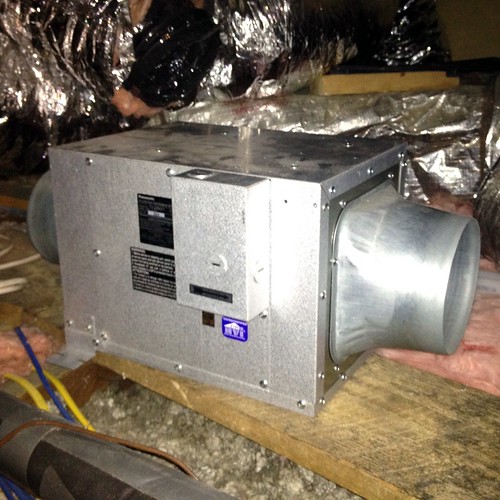Before we get started on today's post, we just wanted to let you know that we announced the winner of our $100 Father's Day gift card to The Home Depot. Be sure to stop on over to see if you won.
Ok, back to today's post...
One of the features I always remember from homes of my childhood were the loud and obnoxious ventilation exhaust fans in bathrooms. My parents consistently scolded reminded me how important it was to turn them on each time I took a shower, and as a result I always hated them. (I know, it's an odd thing to obsess about as a youngster.)
Their audible whir would rattle along in an often failed attempt to remove the humidity from the bathroom in which it was installed. More typically sounding like a hamster wildly running on a wheel in need of grease, their integrated lights and yellowed plastic surrounds often looked to be the most out of place elements on any given bathroom ceiling. I always found the fans that doubled as heat lamps, very 70s chic, to be the most grotesquely charming. Are these relic fans functional? Debatable. Aesthetically pleasing? Heck no. Something that can be done better? Absolutely.
Unless you're dealing with an exhaust fan in a powder room where you want to leverage its talents as a noise maker to mask unpleasant commode sounds, a vent fan should not be seen nor heard, but should do its job and then some.
When we decided to renovate our bathrooms we pledged to figure out a better way to manage steam/odor removal from the rooms. What we ended up with is a more than workable solution that has resulted in many a guest saying "Now, how do I turn the fan on? Oh, it is on? Wow, I don't hear it at all."
Using Panasonic's line of quiet inline duct fans, we were able to locate the fan unit in an out of the way attic location, with only a small vent intake on the ceiling. It's worked wonderfully, and it's mounted in a location where the minor hum can only be heard when standing still and silent in the hallway (below where it's mounted).
We like the end results of our guest bath fan so much that we're using the same brand and line for our master bathroom, though the challenges we're facing are slightly different.
First, the bathroom's space is far larger, so we need a vent fan that can remove significantly more air, or a higher CFM (cubic feet/minute). And second, the mounting locations available in the attic would place this fan directly above our master bedroom's bed. The last thing we want is for the hum of this larger (but apparently still very quiet) unit to transfer through the ceiling joists and into our bedroom.
I came up with a little system that should solve our problem. Once I had run all of the ductwork for this fan and secured it in the attic, I realized there was an alternate mounting method. Rather than affix it to something that would rest on the ceiling joists...
...I could suspend it from the roof rafters. This would allow the device to operate without coming into contact with anything that would transfer sound into our sleeping space.
In order to accomplish this I needed to build something to suspend the fan from the roof rafters. I measured the rough dimensions of the unit itself, then built a small 12"x17" sled with side supports that would act as a platform for the unit.
The other great part about this project is that I used a portion of my hoard of extra scrap wood in the basement to build the whole thing. That's a win for the hoarder in me. :-)
After the sled was constructed, I attached a couple of wood support pieces (think legs of a table) that I could screw to the roof rafters. Since the roof slopes about three inches for every foot of run, I had to make one side shorter than the other.
Once I had everything attached and level (this was a bear in this cramped and hot space I assure you), I tested out the fit of the unit. It was perfect.
Proud of my improvised accomplishment, I screwed the base of the unit to the sled and attached the duct to either side of the fan, and the end of the duct to the roof vent. We were in business and this is yet another item I can check off of our seemingly miles long list.
I emerged from the sauna that is our attic absolutely victorious, with the knowledge that our bathroom fan will do its duty. The inline fan will adequately vent out bathroom space while remaining nearly whisper quiet and unobtrusive in the process. Mission accomplished.
Do you see the dark parts of my pants and shirt? Yep, that's all sweat. Crazy attic sauna!
What are your thoughts on exhaust vent fans? Love 'em? Hate 'em? Don't use 'em? Don't think about 'em? Would you rather your vent fan be a loud, rickety 70s model in order to mask sounds? We'd love to hear your spin on the subject.

![]()
![]()